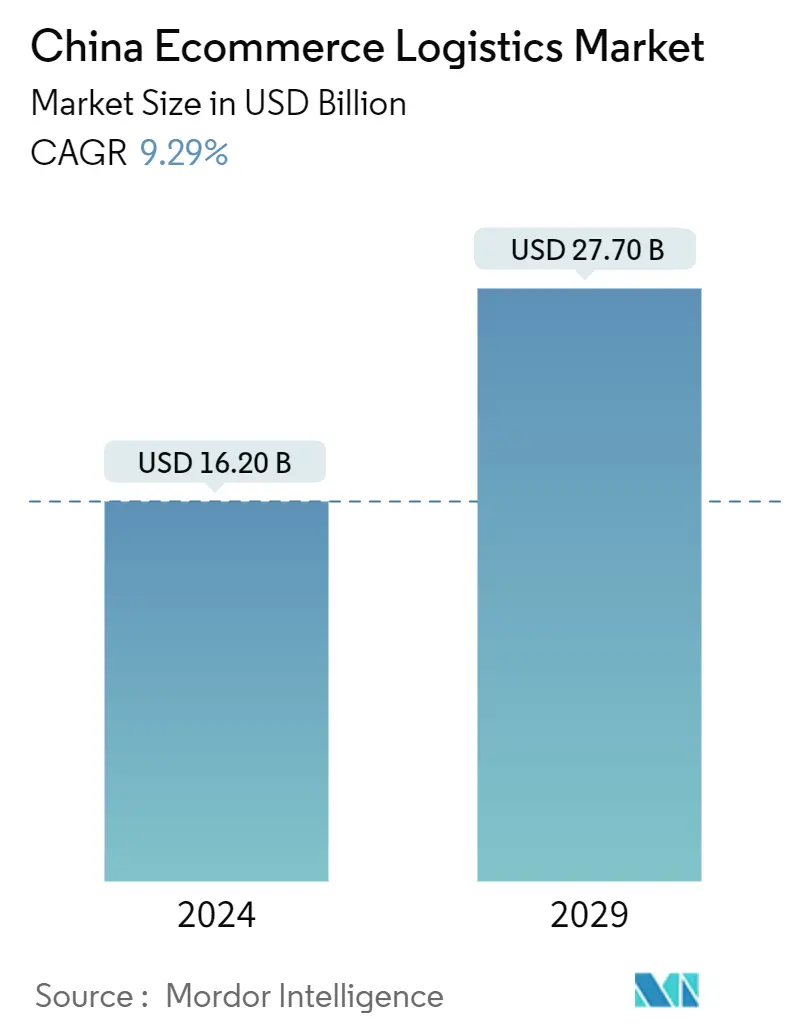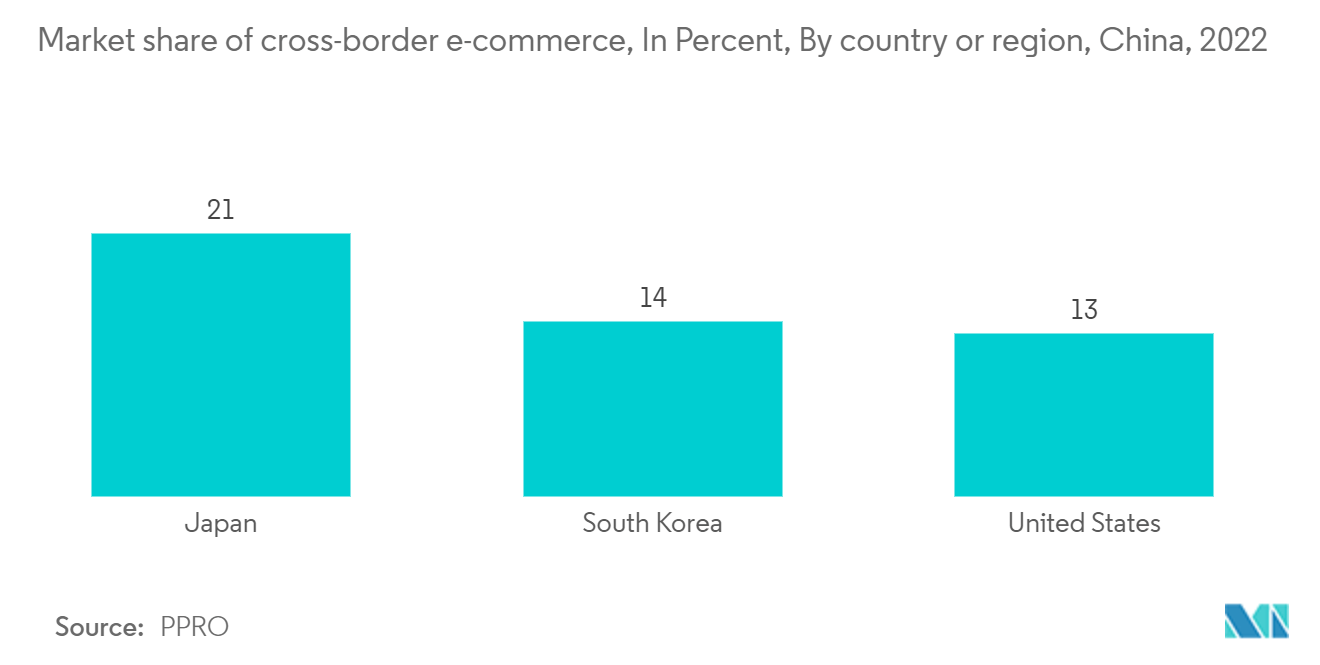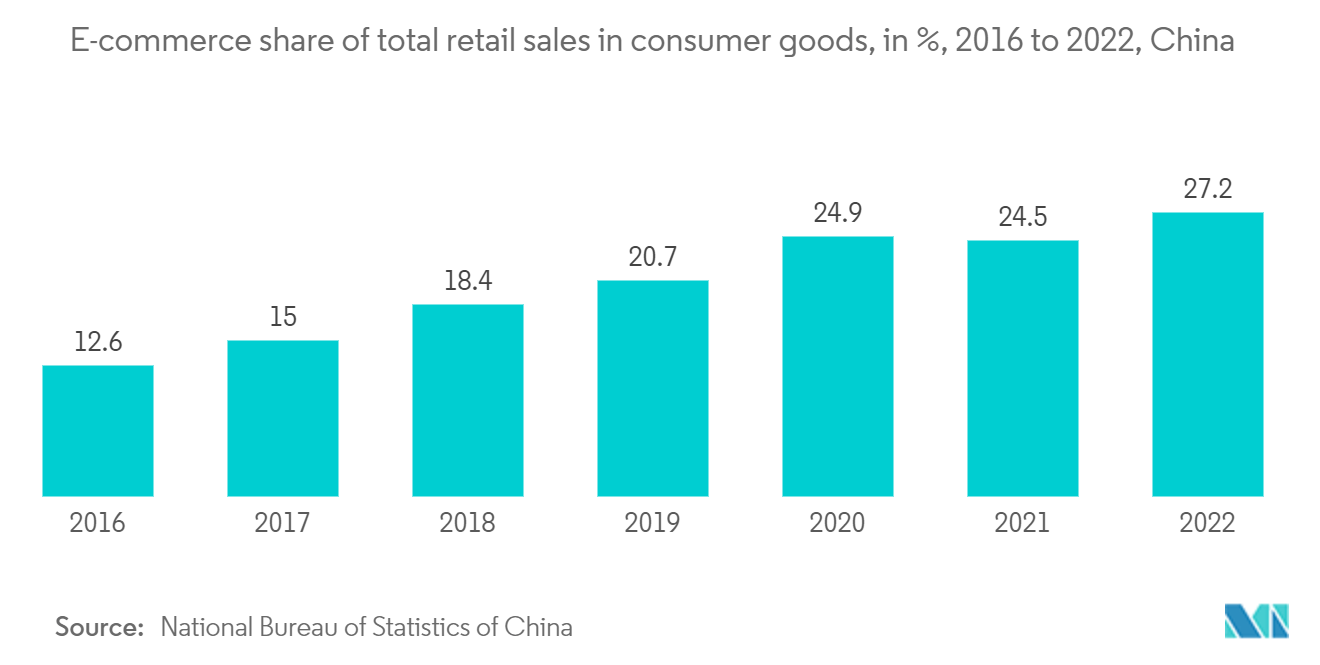China Ecommerce Logistics Market Size

| Study Period | 2020-2029 |
| Base Year For Estimation | 2023 |
| Market Size (2024) | USD 16.20 Billion |
| Market Size (2029) | USD 27.70 Billion |
| CAGR (2024 - 2029) | 9.29 % |
| Market Concentration | Low |
Major Players
*Disclaimer: Major Players sorted in no particular order |
China Ecommerce Logistics Market Analysis
The China Ecommerce Logistics Market size is estimated at USD 16.20 billion in 2024, and is expected to reach USD 27.70 billion by 2029, growing at a CAGR of 9.29% during the forecast period (2024-2029).
- China's e-commerce logistics Index increased in December 2023 by 4.2 points, year on year, as the activity of the sector continued to grow, according to industry data.
- The e-commerce logistic index in December 2023 was 112.4, which was 0.7 points lower than in November 2023. The decline in the Index was attributed to a decrease in demand, as the sales promotions of large e-commerce platforms were heavily focused on the large annual shopping festival of November.
- The demand for e-commerce logistics continued to be high in December, particularly for winter clothing and ice and snow tourism equipment. The Chinese e-commerce logistics industry is expected to remain strong in January 2024, supported by holiday consumption and the acceleration of the ice and snow economy.
- As of August of 2023, One-third of the world’s e-commerce market is in China, according to payment value.
- In the past five years, e-commerce in China has seen rapid growth due to smartphone penetration, internet penetration, online shopping, and alternative payment solutions like Alipay and WeChat Pay.
- E-commerce activity in rural areas is also contributing to the market’s growth. In the first half of 2023, the Chinese Ministry of Commerce reported that rural online retail sales grew 12.5 percent compared to the first half of 2022.
China Ecommerce Logistics Market Trends
Cross border eCommerce driving the growth of the market
- China’s e-tailing (online retailing) across borders, mainly in consumer goods, is expected to continue to grow in 2024, resulting in a more balanced revenue mix for the country’s leading cross-border online retailers, consumer goods manufacturers, and logistics operators.
- Supported by supportive policies, relative pricing competitiveness, and overseas logistics capabilities, the growth momentum will be supported by external demand headwinds.
- The government has put measures in place to support the industry, such as encouraging local companies to construct overseas warehouses and establishing cross-border eCommerce pilot zones in most Tier 4 and above cities to facilitate imports and exports of goods.
- With the expansion of overseas warehouses, Chinese retailers are able to ship more bulk goods, position inventory geographically closer to customers and deliver goods more quickly and cheaply to overseas customers.
- The export value of cross-border E-tailing in China continued to increase, with a 69% year-on-year (YoY) growth in Q1 of 23 compared to the overall goods export growth of 8.4%. However, the real volume could be higher, as the statistics do not take into account transactions outside the pilot zones or smaller platforms.
- Major cross-country e-tail platforms that are owned by internet giants such as Alipay, PDD Holdings, ByteDance, and Sea Limited are expected to benefit from the growing sales through their own websites and apps.
- A few independent e-tailers that have their own distribution channels, including Banggood (B2C), Shein (B2C), and Lintin (Lintin) Holding Co., Ltd. (LTC), could also regain the traction that they had in the past few years.

Growth in Retail e-commerce sales is driving the growth of the market
- According to the National Bureau of Statistics of the People's Republic of China, consumer goods sales in the country increased significantly in September 2023.
- Total retail sales in China in September 2023 reached RMB 3,922.6 billion (USD 551.57 billion), up 5.5% from the same month last year. The increase in consumer goods was more significant in the non-auto sectors, growing by 5.9%.
- In the period January to September, the total retail sales amounted to RMB 34,210.7 billion (USD 4811.24 billion). This represents an increase of 6.8%. Urban and rural areas both saw an increase in retail sales, with urban sales rising by 6.7% and rural sales rising by 7.4%, respectively. These numbers show that the Chinese consumer market is stable, reflecting the strength of the Chinese economy and consumer confidence.
- In particular, the increase in rural areas shows that the market base is growing, opening up new opportunities for global tech companies.
- The increase in non-auto retail sales suggests a change in consumer preferences. This shift may be driven by technological innovation and lifestyle changes. This shift gives tech companies the opportunity to innovate in the consumer goods space by combining technology with consumer products.

China Ecommerce Logistics Industry Overview
The China e-commerce logistics market is fragmented, and as the demand for logistics services is growing rapidly across the region, companies are becoming more competitive to capture the huge opportunity.
As a result, international players are making strategic investments to establish a regional logistics network, such as opening new distribution centers, smart warehouses, etc. Some of the leading players include DHL Logistics,DB Schenker, FedEx Express, XPO Logistics, SF Express etc.
China Ecommerce Logistics Market Leaders
-
DHL Logistics
-
DB Schenker
-
FedEx Express
-
XPO Logistics
-
SF Express
*Disclaimer: Major Players sorted in no particular order

China Ecommerce Logistics Market News
- October 2023: DHL inaugurated a new gateway in Wuxi, Jiangsu Province, East China, as part of its ongoing expansion initiatives. Simultaneously, DHL is extending its North Asia Hub in Shanghai Pudong, reinforcing the company's network resilience and service capabilities.
- May 2023: FedEx Express (FedEx), a subsidiary of FedEx Corp, announced a strategic partnership agreement with the Guangzhou Municipal Government. Under the Memorandum of Understanding (MoU), FedEx and the Guangzhou Municipal Government (GMB) will collaborate on customs clearance, international e-commerce, and the South China Operations Center (SCOC). The GGB and FedEx will mutually support strategic initiatives and business growth in Guangzhou, enhancing e-commerce logistics and bolstering Guangzhou's role as an international cargo center.
China Ecommerce Logistics Market Report - Table of Contents
1. INTRODUCTION
- 1.1 Study Deliverables
- 1.2 Study Assumptions
- 1.3 Scope of the Study
2. RESEARCH METHODOLOGY
3. EXECUTIVE SUMMARY
4. MARKET INSIGHTS
- 4.1 Current Market Scenario
- 4.2 Technological Trends in the Industry
- 4.3 Government Initiatives and Regulations
- 4.4 Insights on the E-commerce Market
- 4.5 Insights on Reverse/Return Logistics
- 4.6 Impact of COVID-19 on the Market
5. MARKET DYNAMICS
-
5.1 Market Drivers
- 5.1.1 Booming mobile commerce
- 5.1.2 Massive online market
-
5.2 Market Restraints / Challenges
- 5.2.1 Geographic size and population density
- 5.2.2 Fragmented supply chain
-
5.3 Market Opportunities
- 5.3.1 Last mile delivery solutions
- 5.3.2 Supply chain optimization
-
5.4 Industry Attractiveness - Porter's Five Forces Analysis
- 5.4.1 Threat of New Entrants
- 5.4.2 Bargaining Power of Buyers/Consumers
- 5.4.3 Bargaining Power of Suppliers
- 5.4.4 Threat of Substitute Products
- 5.4.5 Intensity of Competitive Rivalry
6. MARKET SEGMENTATION
-
6.1 By Service
- 6.1.1 Transportation
- 6.1.2 Warehousing and Inventory management
- 6.1.3 Value-Added Services (Labeling, Packaging, etc)
-
6.2 By Business
- 6.2.1 B2B
- 6.2.2 B2C
-
6.3 By Destination
- 6.3.1 Domestic
- 6.3.2 International/Cross-border
-
6.4 By Product
- 6.4.1 Fashion and Apparel
- 6.4.2 Consumer Electronics
- 6.4.3 Home Appliances
- 6.4.4 Furniture
- 6.4.5 Beauty and Personal Care Products
- 6.4.6 Other Products (Toys, Food Products, etc.)
7. COMPETITIVE LANDSCAPE
- 7.1 Market Concentration Overview
-
7.2 Company Profiles
- 7.2.1 DHL Logistics
- 7.2.2 DB Schenker
- 7.2.3 FedEx Express
- 7.2.4 XPO Logistics
- 7.2.5 SF Express
- 7.2.6 CEVA Logistics
- 7.2.7 Nippon Express
- 7.2.8 CTS International Logistics
- 7.2.9 VHK Logistics
- 7.2.10 Yusen Logistics*
- *List Not Exhaustive
8. FUTURE OF THE MARKET
9. APPENDIX
10. DISCLAIMER ABOUT US
** Subject To AvailablityChina Ecommerce Logistics Industry Segmentation
E-commerce logistics refers to the transportation, warehousing, and distribution services provided to an online retailer by the logistics company.
The China e-commerce logistics market is segmented by service, business, destination, and product. By service, the market is segmented by transportation, warehousing and inventory management, and value-added services (labeling and packaging). By business, the market is segmented by B2B and B2C. By destination, the market is segmented by domestic and international/cross-border. By product, the market is segmented by fashion and apparel, consumer electronics, home appliances, furniture, beauty and personal care products, and other products (toys, food products, etc.)).
The report offers market size and forecast in value (USD) for all the above segments.
| By Service | Transportation |
| Warehousing and Inventory management | |
| Value-Added Services (Labeling, Packaging, etc) | |
| By Business | B2B |
| B2C | |
| By Destination | Domestic |
| International/Cross-border | |
| By Product | Fashion and Apparel |
| Consumer Electronics | |
| Home Appliances | |
| Furniture | |
| Beauty and Personal Care Products | |
| Other Products (Toys, Food Products, etc.) |
China Ecommerce Logistics Market Research FAQs
How big is the China Ecommerce Logistics Market?
The China Ecommerce Logistics Market size is expected to reach USD 16.20 billion in 2024 and grow at a CAGR of 9.29% to reach USD 27.70 billion by 2029.
What is the current China Ecommerce Logistics Market size?
In 2024, the China Ecommerce Logistics Market size is expected to reach USD 16.20 billion.
Who are the key players in China Ecommerce Logistics Market?
DHL Logistics, DB Schenker, FedEx Express, XPO Logistics and SF Express are the major companies operating in the China Ecommerce Logistics Market.
What years does this China Ecommerce Logistics Market cover, and what was the market size in 2023?
In 2023, the China Ecommerce Logistics Market size was estimated at USD 14.70 billion. The report covers the China Ecommerce Logistics Market historical market size for years: 2020, 2021, 2022 and 2023. The report also forecasts the China Ecommerce Logistics Market size for years: 2024, 2025, 2026, 2027, 2028 and 2029.
China Ecommerce Logistics Industry Report
Statistics for the 2024 China Ecommerce Logistics market share, size and revenue growth rate, created by Mordor Intelligence™ Industry Reports. China Ecommerce Logistics analysis includes a market forecast outlook 2029 and historical overview. Get a sample of this industry analysis as a free report PDF download.



